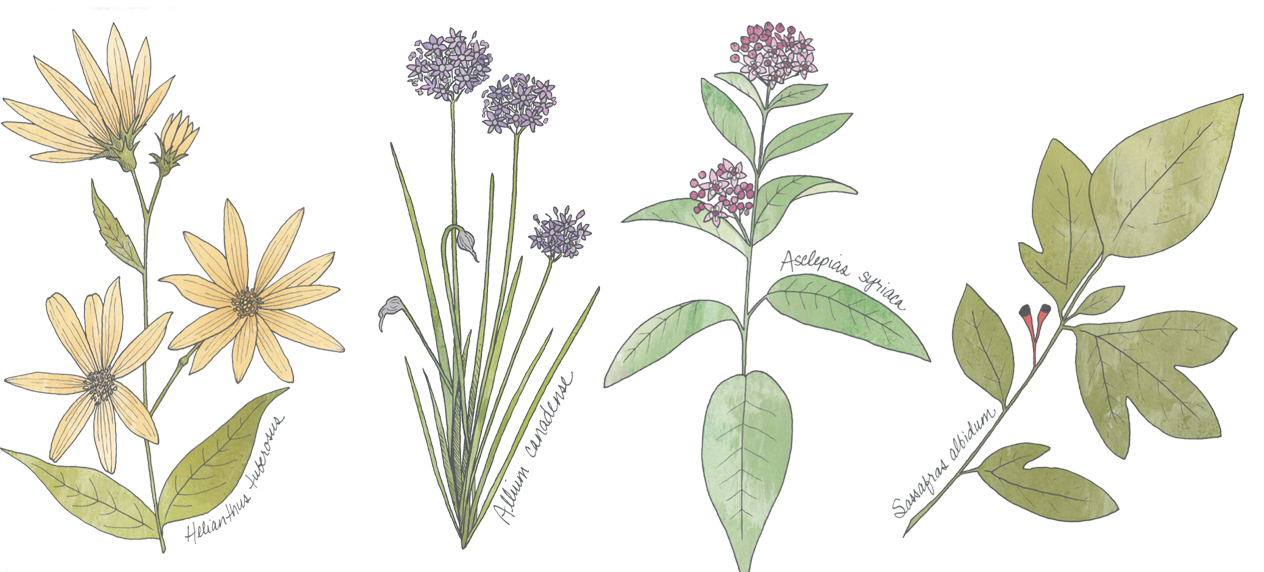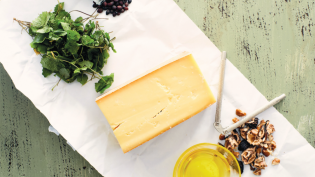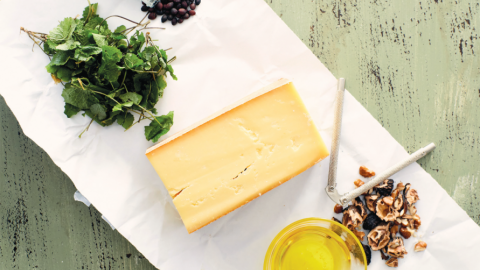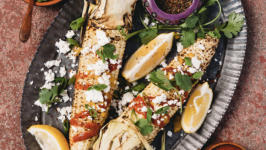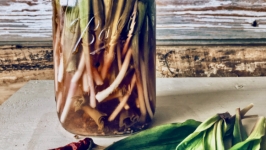Chef D’s Spring Favorites
Daylilies (Hemerocallis lilioasphodelus)
These are some of the earliest foraged items you will find in Indiana. The light green shoots taste like sweet lettuce. Later in the season, when they begin to flower, harvest the pods before they bloom. They are great in stir-fry, like you would pea pods or snow peas. You can also pickle (see our pickled daylily recipe on page 8) or dry the unopened blossoms; they make a great addition to Chinese egg drop soup. In the traditional Chinese egg drop soup, dried daylilies are an integral part of the soup, giving it that viscous texture as well as a nice, floral flavor. And finally, when the bright orange flower blooms, you can eat the petals, putting them on a salad, or tempura them in a light batter, sprinkle with powdered sugar and you have dessert.
Dandelion Greens (Taraxacum officinale)
In the spring, when they first come out, they are delicious. As the sun beats down on them, they’ll get much stronger and much more bitter. They’re also usually really easy to pull in the spring. You can pull them with the whole root and eat the roots, greens and flowers. I like to dip the flowers in a tempura batter and then fry them. The greens are a little bit bitter. For some people, I always suggest they put a little bacon, which has the fatty, smoky flavor, and then something a little bit sweet like some diced apples or some fresh berries, and then finish them with something acidic like vinegar. The combination of fat, sweet and sour is really good to make some of the more pungent and aggressive wild greens more palatable to the uninitiated palate. You can also throw some roasted beets in with them, which gives a natural sweetness and earthy flavors that are great with some olive oil or butter. When we were growing up, we would eat the dandelion greens with my grandparents. They would pick and braise the greens. They would pour off the cooking liquids they called the “pot liquor” and serve it like a broth in a tea cup with a bit of malt vinegar and a pat of butter on top as a healthy tonic. The greens were then served with the roast as well as some grits. That’s kind of an old, homey way to enjoy dandelions. That’s how my grandparents did it.
Sweet Violets (Viola odorata)
Harvest the heart-shaped violet leaves when they’re young and tender and use in salads or as cooked greens. Their purple, white or variegated flowers are also delicious as salad or pastry garnishes. Don’t pick any foraged foods from a yard that’s been treated with chemicals. I have a patch of violets at my cabin in Monroe County and also in Columbus. I pick those because I know they are chemical free. And there are knowledgeable local foragers who harvest them for the restaurant.
Garlic Mustard Greens (Sisymbrium alliaria)
An invasive plant, they’ve got a strong, garlic flavor as well as a nice mustardy heat. I love to make pesto out of them. You can grind them with spinach, and add additional garlic and olive oil, then freeze the pesto in small containers. Then, whenever you want to make a Tuscan pasta, especially if you’re using something like ravioli that’s got some rich filling, the garlicky mustard pesto plays off the richness of the ravioli. When serving a creamy alfredo sauce, you can use a dollop of the pesto on top of your plated pasta: It will cut that cloying richness of the sauce.
Jerusalem Artichokes (Helianthus tuberosus)
A root veggie that grows a lot of places all over Southern Indiana. They look like little, tiny sunflowers. I have some wild ones I’m growing and the roots are getting bigger and bigger as they become at home with the soil they’re in. You can harvest them all winter long and into the spring. They’re delicious. You can make chips out of them, or mash them like potatoes, or make wonderful soups.
Wild Onions (Allium canadense)
Use when small and “chive-like.” Chop them up and make wild onion compound butter to use on grilled steaks or fish. Let some of them grow up and flower. Wild onions have a big seed head that looks like an alien with these green shoots coming out of them. I make a mixture of vinegar, salts, sugar, water and black peppercorns and I pour it over the wild onions and let it sit for a couple weeks. That makes my wild onion vinegar for Christmastime, and it’s shelf stable, as long as everything is covered with vinegar.
Milkweed (Asclepias syriaca)
This plant shows up a little bit later in the summer. Never pick the whole patch of milkweed because you want to leave some for the monarch butterflies. The monarchs eat them and put their cocoons on those plants, and when the flowers bloom the mature monarchs will feed off the flowers of the milkweed. That said, it does make a really good vegetable. Before it blooms, milkweed looks like little heads of broccoli. You want to pick them when they’re fairly young. You can steam those and eat just like you would broccoli. (Chef D thinks they are better than broccoli.) You can also take the little, young pods, and pickle them and use them like capers. [Editor’s note: The mature leaves and “seed pods” eaten in large quantities can be toxic.]
Sassafras Leaves (Sassafras albidum)
You need to harvest sassafras leaves very young and dry them very carefully so they stay nice and green. Then put them in a spice grinder and grind to make your own gumbo file powder. It almost has a kind of green tea flavor. It will thicken your gumbo and then you can sprinkle some on your rice. If you do it right, it will be a very vibrant green. It’s very pretty and looks like matcha.
Tips for the Foraging Trade
Be 100% Sure It’s Safe
Before you put anything in your mouth, make sure it is truly an edible. Check your guides or go online and Google what you’ve found. There are many online groups, too, to find an expert. If you’re not 100% sure of what it is, don’t eat it.
Start With One Plant
Summer Cooper recommends getting to know one plant at a time when foraging. Find “your mushroom” and then learn everything there is to know about it. Then move onto the next plant. There is time, and the more you know the more you’ll start to find.
Moderation
When deciding to cook with foraged ingredients, taste a little at a time to make sure your system can tolerate the plant. Jerusalem artichokes, for instance, induce gas, so take some Beano or pair them with fennel to help reduce the effects. Go slow to know what’s best for your body.
Clean Sources
Forage on land that is clean, staying away from chemically treated lawns, roadsides and creeks and riverbeds where there is any type of drainage. Look to state parks where foraging is permissible, a friend’s forest where you know they don’t use chemicals, and other safe sources.
Keeping Greens Fresh
When you get those wild greens home from the forest floor, what next? Chef D has a good tip to keep them fresh in your fridge.
“Wash them very well with room-temperature water. The sand and dirt tends to fall off easily with warmer water. Then when cooling them to put them in the refrigerator, I drop them into an ice water bath and bring their temperature down to a cold temp. Spin them in a salad spinner, put them in Ziploc bags and I put holes in the bag so the greens can breathe. I use a hole punch and punch holes in the plastic bags all over the place so they’re not sitting in there without any air circulation. Then I put the greens in the bag and store them in the refrigerator.”


